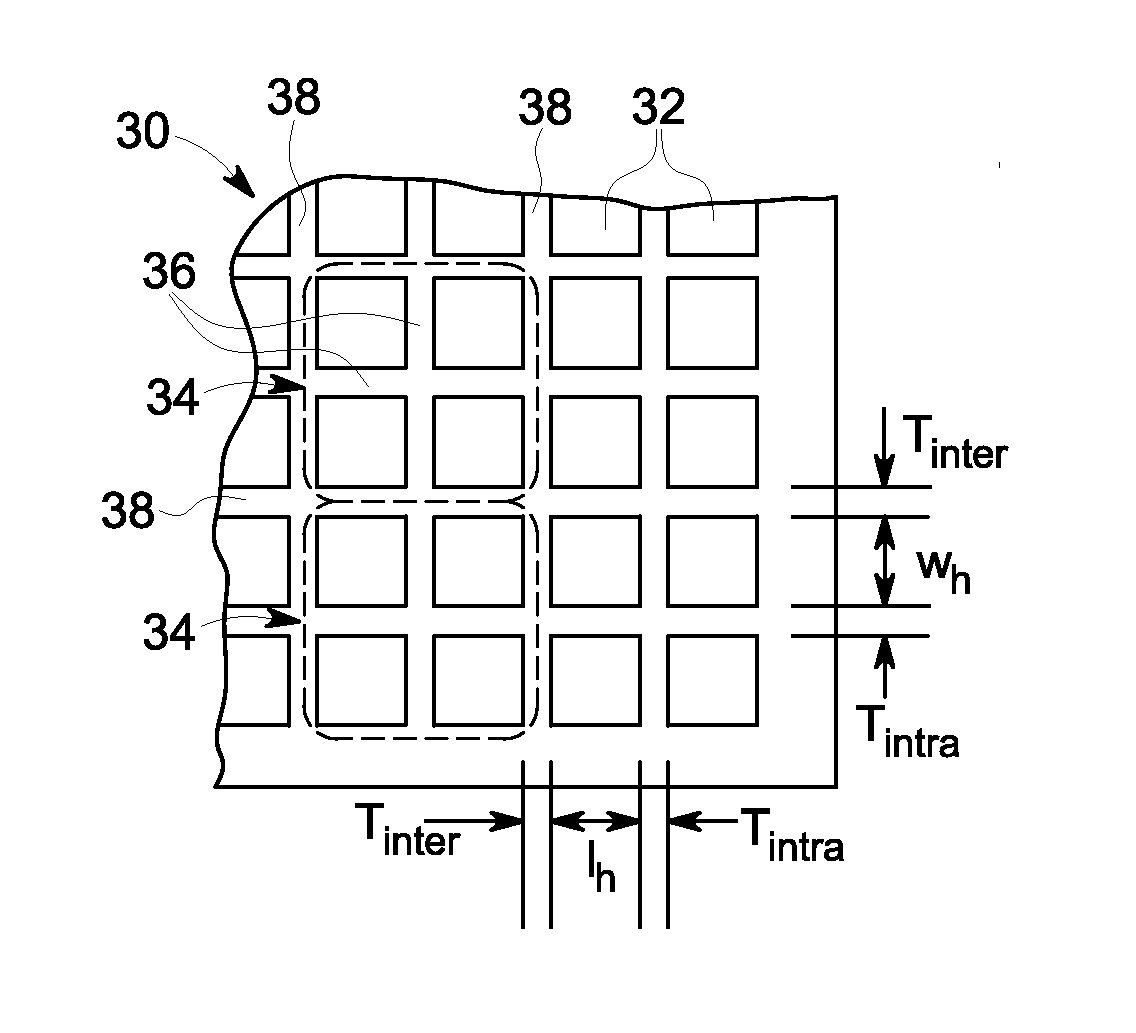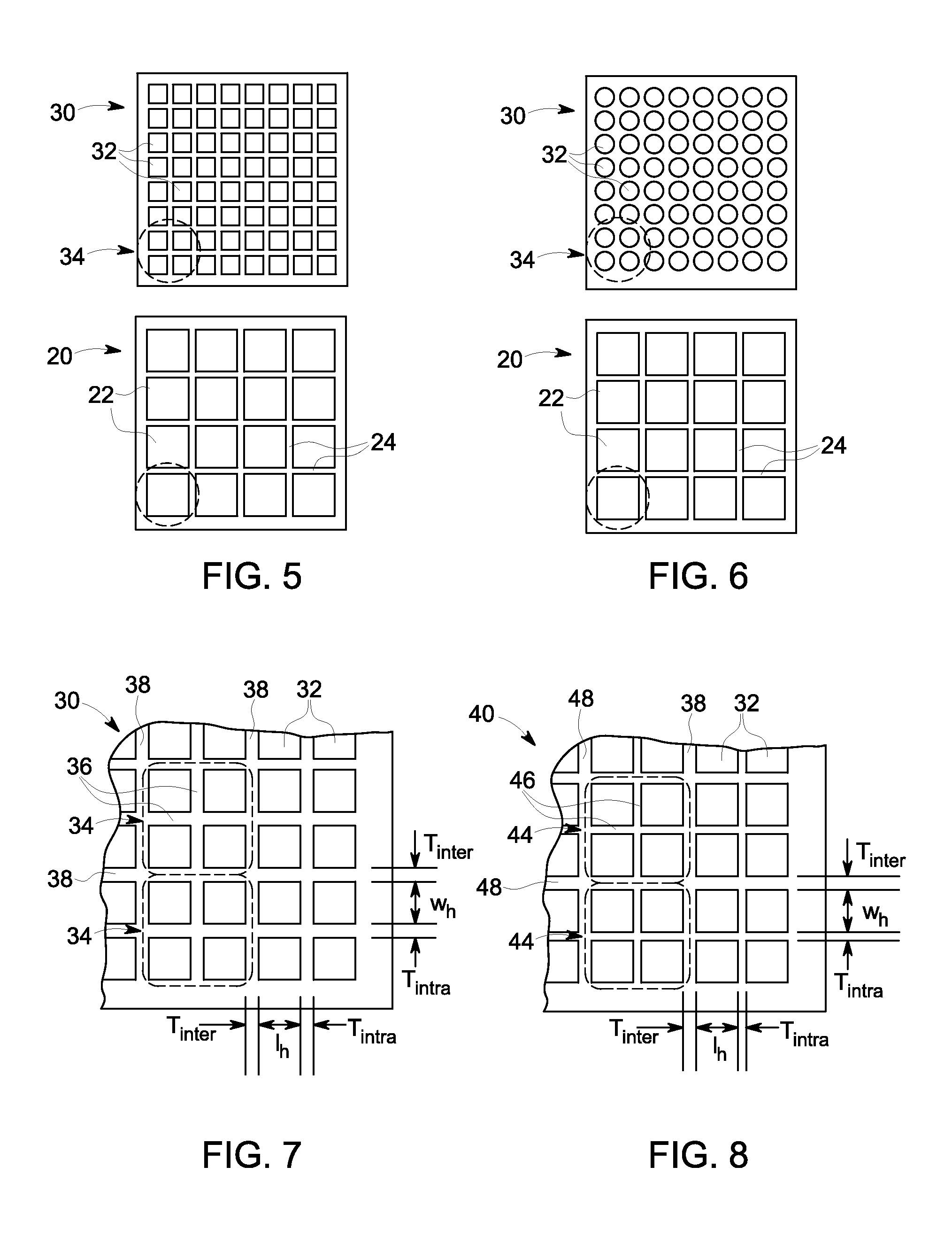Collimator for a pixelated detector
a collimator and detector technology, applied in the field of collimator for collimating photons, can solve the problems of reducing detector efficiency, limiting the overall image quality and performance of resolution-sensitivity tradeoff, etc., and achieve the effect of reducing heigh
- Summary
- Abstract
- Description
- Claims
- Application Information
AI Technical Summary
Benefits of technology
Problems solved by technology
Method used
Image
Examples
first embodiment
[0071]Referring now to the drawings, FIG. 5 shows the present invention, in which a collimator 30 may be associated with a pixelated detector 20. While prior art collimators for use with pixelated detectors have one collimator hole or channel per detector pixel, embodiments of the present invention utilize multiple holes per pixel. The collimator 30 has holes 32 arranged in groups 34, wherein each group 34 corresponds in overall size and location to a respective detector pixel 22 on the detector 20. This creates unique one-to-one registrations between each one of the groups 34 of holes 32 and its respective associated pixel element 22. In other words, each group of holes aligns with only one pixel element, and each pixel element is aligned with only one group of holes. The collimator 30 may be placed over the detector 20 so that each detector pixel 22 is covered by a group 34 of collimator holes 32, with the centroid of each group 34 of holes 32 being generally projectively aligned ...
third embodiment
[0076]the present invention is shown in FIGS. 10-12. In this embodiment, the intra-group septa 56 are recessed from the top and / or bottom surface of the collimator such that the height hs of these septa 56 is less than the overall height Hc of the collimator 50. It should be noted that although FIG. 10 only shows these septa 56 as being recessed from the “top” surface, it is equally within the scope of the present embodiment that the intra-group septa 56 can be recessed from the other (“bottom”) surface of the collimator, or from both surfaces. In a configuration according to this embodiment, the overall height Hc of the collimator can be the same as that of an otherwise conventional collimator, or it can be made smaller. Also, although FIGS. 10-12 show the thickness Tintra of the intra-group septa 56 as being smaller than the thickness Tinter of the inter-group septa 58, it is within the scope of this embodiment that these thicknesses (Tintra and Tinter) can optionally be the same....
second embodiment
[0081]Rows 9 and 10 show modifications made in which the collimator also uses four holes per pixel, but also includes reducing the intra-group septum thickness Tintra to 0.025 mm. This allows the inter-group septum thickness Tinter to be reduced, while still maintaining a thin collimator (i.e., very low Hc) with high sensitivity and low septal penetration. Rows 11 and 12 show the intra-group septum thickness Tintra being further reduced to 0.020 mm, which enables the inter-group septum thickness Tinter and collimator height Hc to remain about the same as rows 9 and 10, but with improved sensitivity compared to rows 9 and 10.
TABLE 1Inter-groupIntra-groupPixelCollimatorSeptumResolutionSeptumPitch,Height,Thickness,RelativeFWHMThickness,RowPpHcTinterSensitivitySensitivity,@ 3.0 cmSeptalTintra#(mm)Material(mm)(mm)(cpm / μCi)RS(mm)Penetration(mm)Comments11.6 W9.40.3819721.005.0611.44%N / AGM actual22.46Pb21.00.4012670.644.8000.87%N / AGE actual32.46Pb19.30.4015110.7664.9991.28%N / ALower GE heig...
PUM
 Login to View More
Login to View More Abstract
Description
Claims
Application Information
 Login to View More
Login to View More - R&D
- Intellectual Property
- Life Sciences
- Materials
- Tech Scout
- Unparalleled Data Quality
- Higher Quality Content
- 60% Fewer Hallucinations
Browse by: Latest US Patents, China's latest patents, Technical Efficacy Thesaurus, Application Domain, Technology Topic, Popular Technical Reports.
© 2025 PatSnap. All rights reserved.Legal|Privacy policy|Modern Slavery Act Transparency Statement|Sitemap|About US| Contact US: help@patsnap.com



